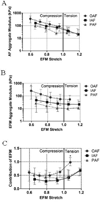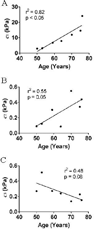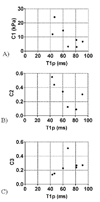Mechanical properties of the extra-fibrillar matrix of human annulus fibrosus are location and age dependent
- PMID: 23818058
- PMCID: PMC4164199
- DOI: 10.1002/jor.22430
Mechanical properties of the extra-fibrillar matrix of human annulus fibrosus are location and age dependent
Abstract
The mechanical behavior of the annulus fibrosus (AF) of the intervertebral disc can be modeled as a mixture of fibers, extra-fibrillar matrix (EFM), ions, and fluid. However, the properties of the EFM have not been measured directly. We measured mechanical properties of the human EFM at several locations, determined the effect of age and degeneration, and evaluated whether changes in EFM properties correspond to AF compositional changes. EFM mechanical properties were measured using a method that combines osmotic loading and confined compression. AF samples were dissected from several locations, and mechanical properties were correlated with age, degeneration, and composition. EFM modulus was found to range between 10 and 50 kPa, increasing nonlinearly with compression magnitude and being highest in the AF outer-anterior region. EFM properties were not correlated with composition or degeneration. However, the EFM modulus, its relative contribution to tissue modulus, and model parameters were correlated with age. These measurements will result in more accurate predictions of deformations in the intervertebral disc. Additionally, parameters such as permeability and diffusivity used for biotransport analysis of glucose and other solutes depend on EFM deformation. Consequently, the accuracy of biotransport simulations will be greatly improved.
Keywords: annulus fibrosus; extra-fibrillar matrix; mechanical properties; osmotic pressure.
© 2013 Orthopaedic Research Society. Published by Wiley Periodicals, Inc.
Figures






Similar articles
-
Elastic, permeability and swelling properties of human intervertebral disc tissues: A benchmark for tissue engineering.J Biomech. 2014 Jun 27;47(9):2088-94. doi: 10.1016/j.jbiomech.2013.12.021. Epub 2013 Dec 25. J Biomech. 2014. PMID: 24438768 Free PMC article.
-
Extra-fibrillar matrix mechanics of annulus fibrosus in tension and compression.Biomech Model Mechanobiol. 2012 Jul;11(6):781-90. doi: 10.1007/s10237-011-0351-x. Epub 2011 Oct 2. Biomech Model Mechanobiol. 2012. PMID: 21964839 Free PMC article.
-
Effect of aggrecan degradation on the nanomechanics of hyaluronan in extra-fibrillar matrix of annulus fibrosus: A molecular dynamics investigation.J Mech Behav Biomed Mater. 2020 Jul;107:103752. doi: 10.1016/j.jmbbm.2020.103752. Epub 2020 Apr 1. J Mech Behav Biomed Mater. 2020. PMID: 32278311
-
Mechanobiology of the intervertebral disc and relevance to disc degeneration.J Bone Joint Surg Am. 2006 Apr;88 Suppl 2:52-7. doi: 10.2106/JBJS.F.00001. J Bone Joint Surg Am. 2006. PMID: 16595444 Review.
-
Structure and mechanical function of the inter-lamellar matrix of the annulus fibrosus in the disc.J Orthop Res. 2016 Aug;34(8):1307-15. doi: 10.1002/jor.23306. Epub 2016 Jun 14. J Orthop Res. 2016. PMID: 27208689 Review.
Cited by
-
Regional variations in the cellular, biochemical, and biomechanical characteristics of rabbit annulus fibrosus.PLoS One. 2014 Mar 12;9(3):e91799. doi: 10.1371/journal.pone.0091799. eCollection 2014. PLoS One. 2014. PMID: 24622282 Free PMC article.
-
Multiscale regression modeling in mouse supraspinatus tendons reveals that dynamic processes act as mediators in structure-function relationships.J Biomech. 2016 Jun 14;49(9):1649-1657. doi: 10.1016/j.jbiomech.2016.03.053. Epub 2016 Apr 2. J Biomech. 2016. PMID: 27067362 Free PMC article.
-
Derivation of inter-lamellar behaviour of the intervertebral disc annulus.J Mech Behav Biomed Mater. 2015 Aug;48:164-172. doi: 10.1016/j.jmbbm.2015.03.028. Epub 2015 Apr 13. J Mech Behav Biomed Mater. 2015. PMID: 25955558 Free PMC article.
-
Elastic, permeability and swelling properties of human intervertebral disc tissues: A benchmark for tissue engineering.J Biomech. 2014 Jun 27;47(9):2088-94. doi: 10.1016/j.jbiomech.2013.12.021. Epub 2013 Dec 25. J Biomech. 2014. PMID: 24438768 Free PMC article.
-
Age and gender differences in lumbar intervertebral disk strain using mechanical loading magnetic resonance imaging.NMR Biomed. 2023 Nov;36(11):e4999. doi: 10.1002/nbm.4999. Epub 2023 Jul 6. NMR Biomed. 2023. PMID: 37409683 Free PMC article.
References
-
- Ghosh P, Bushell GR, Taylor TF, Akeson WH. Collagens, elastin and noncollagenous protein of the intervertebral disk. Clin. Orthop. Relat. Res. 1977:124–132. - PubMed
-
- Inerot S, Axelsson I. Structure and composition of proteoglycans from human annulus fibrosus. Connect. Tissue Res. 1991;26:47–63. - PubMed
-
- Pearce RH, Grimmer BJ, Adams ME. Degeneration and the chemical composition of the human lumbar intervertebral disc. J. Orthop. Res. 1987;5:198–205. - PubMed
-
- Eyre DR. Biochemistry of the intervertebral disc. Int Rev Connect Tissue Res. 1979;8:227–291. - PubMed
MeSH terms
Substances
Grants and funding
LinkOut - more resources
Full Text Sources
Other Literature Sources

